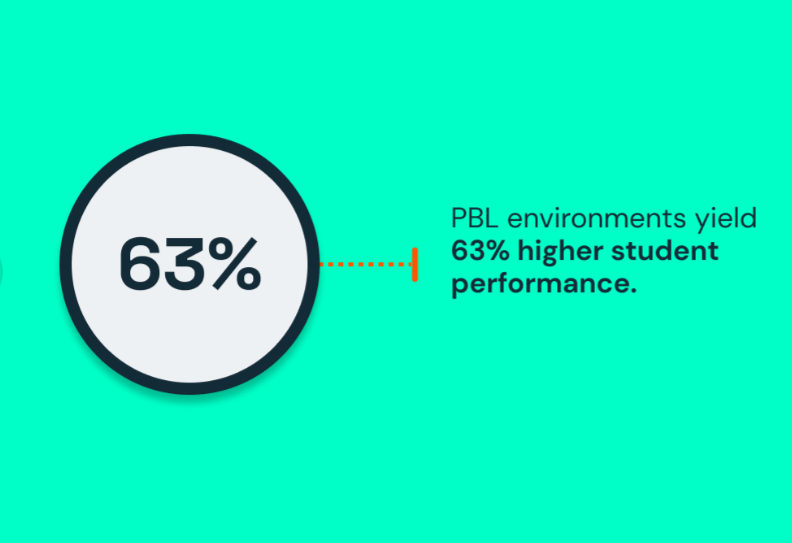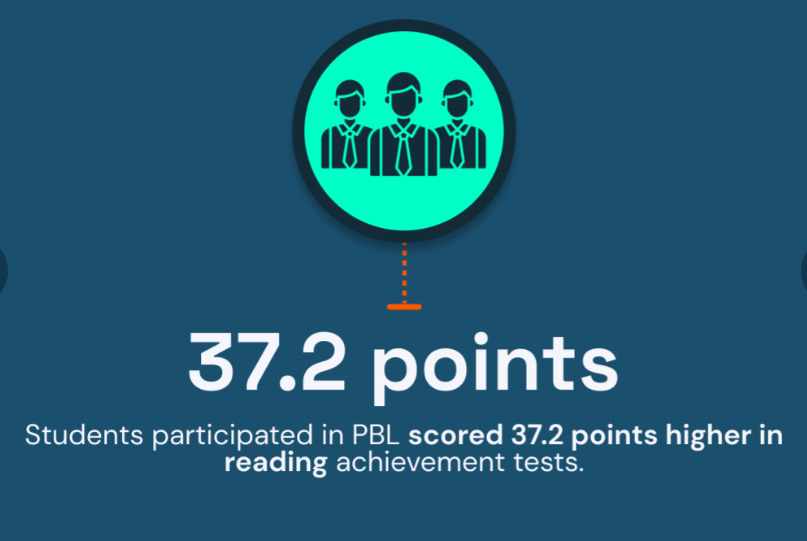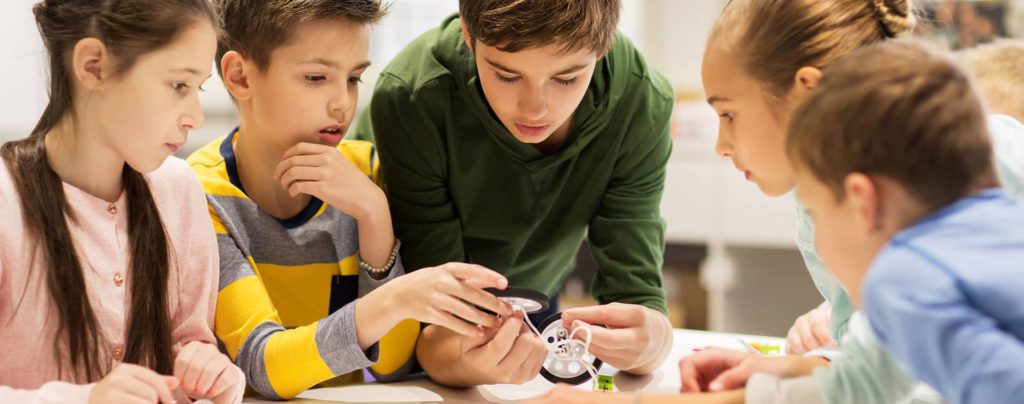Update: This article was last updated on 28th March 2024 to reflect the accuracy and up-to-date information on the page.
Project Based Learning (PBL) environments experience 63% greater gains in student performance than traditional teaching methods: ZipDo

The conventional approach and old-school model of learning and reciting facts is no longer a sustainable way of moving ahead in today’s highly technological society. Project-Based Learning (PBL) is an impactful teaching technique that enlightens students with skills and knowledge, varying from project management to assertiveness.
As per the Buck Institute for Education (BIE), with PBL students investigate and respond to an authentic, engaging, and complex problem, or challenge, with deep and sustained attention. ArchForKids LLC explains it even more precisely, therefore PBL is “learning by doing”.
Various other studies have highlighted significant improvements in student test scores, attendance, and classroom engagement. There is a great requirement for 21st-century students to carry skills like time management, information synthesizing, problem-solving, research gathering, teamwork, critical thinking, communicating, and utilizing high-tech tools.

Source: ZipDo
Apart from the escalation of academic achievement, PBL is transformative as it focuses on students’ personal growth, making them more aware of their learning process, guided and mentored by a skilled teacher.
Education is the primary concern for the upcoming generation. In the given circumstances and complex society that we live in, PBL is rapidly making an appearance in the minds of the educationists and policymakers, who are willing to introduce it into the education system.
Projects have a creative and viable existence, they are an active source of learning, and it is better to hand out projects to students rather than making them sit and recite it all out for them. This would help the students engage more authentically in the given topics, generate interest, and look for the best and most practical solutions.
Below are various benefits of project-based learning and how it can nurture our kids to look for tangible problems, live in a world of facts, and then come up with practical explanations.
1. Project Management:
Sizing up assignments, setting priorities, and creating a timeline, all these factors help students to facilitate and manage their projects more coherently. Students learn about their strengths and weaknesses and how much effort they’re willing to put into any given project.
2. Collaboration:
Relationships with the teachers, fellow groups, and community members grow strong, giving the students different perspectives and insights at looking towards a project, asking open-ended questions, and tackling challenges for future references and beyond.
3. Less involvement of Teacher:
In PBL, students can teach students. Any given student who has grasped the underlying concept of a given topic can create an atmosphere of collective learning by teaching and explaining the methods to other students. Hence, PBL can be a solution for teachers to spend less time catering to each individual in a class.
4. Critical Thinking:
Students become solution-oriented and they are always looking to deal with the potential hindrances in the most efficient way, thinking of ways to find solutions.
5. Creativity:
With an in-depth understanding of their projects and what they want out of them, students think of innovative ideas and various possibilities to execute their plans.
6. Scope of Work:
Another important benefit of PBL is that it allows educators, teachers, and students to swiftly adopt new structures around projects and give up on having lecture-based learning and reading-writing assignments of the traditional approach. Students get an overview of their entire project and how they can move forward with it.
7. Prepared for the Real World:
PBL enables students to face real-world problems in the form of projects. Each project is an experiment, and with each success and failure, they learn something new. PBL students enter the field with enough experience and rationality, realizing the needs of today’s world, and are not disembodied by logical reasoning and the reality of society.
8. Inclusion of Technology:
Students select projects based on their interests and are more likely to have technology involved such as computers, the internet, interactive whiteboards, cameras, and GPS Devices.
9. Tracking of Progress:
In PBL, there is an opportunity to track the progress of the activities of both the students and the teacher. However, this phenomenon is missing and non-existent in the traditional classroom-based structure.
10 . Problem Solving:
Going through the entire process of a project, students face real community issues and can develop a coping mechanism with various stages like project scoping, work planning, activity performing, and tracking. Students learn to monitor, carry out observations, conduct surveys, research, report, present and communicate, and collaborate with people involved.
Implementing Project-Based Learning in educational settings offers numerous benefits, but it comes with its own set of challenges. As educators and policymakers increasingly recognize the value of PBL in fostering critical thinking, collaboration, and problem-solving skills among students, they also grapple with many other obstacles that hinder its successful implementation such as:
1. Resource and Time Constraints:
When we talk about Project-Based Learning, we’re talking about a method that requires a lot of time and resources from teachers and students. But sometimes, especially in schools with limited funds, these resources aren’t readily available, making it tough to do PBL effectively.
2. Assessment Complexity and Teacher Support:
PBL teaches students important skills, but traditional ways of testing might not show how well they’re doing. Teachers need extra training to figure out the best way to grade PBL projects and give students the support they need.
3. Student Engagement and Equity Issues:
PBL is supposed to get students excited about learning, but some kids might find it hard to take charge of their learning. This can make it tough for everyone to get the same opportunities, especially if some students need extra help.
4. Curriculum Alignment & Parental Understanding:
Trying to fit PBL into what students are already learning isn’t always easy. Plus, not everyone, including parents, might understand why PBL is so important. We need to help them see the benefits so they can support it too.
5. Sustainability & Assessing Learned Outcomes:
Making sure PBL keeps going in schools can be tough, especially if things keep changing. We also need to find good ways to measure how well students are learning from PBL, so we can keep improving it.
1. STEM Challenge:
Students design and build a functional device, such as a solar-powered car or a water filtration system, applying principles of science, technology, engineering, and mathematics.
2. Cultural Exchange Program:
Students collaborate with peers from different cultural backgrounds to create multimedia presentations or cultural exhibitions, fostering cross-cultural understanding and communication skills.
3. Entrepreneurship Venture:
Students develop a business plan and prototype for a product or service, learning about market research, budgeting, and marketing strategies.
4. Artistic Expression Project:
Students explore various forms of artistic expression, such as painting, sculpture, or performance art, to communicate ideas and emotions on a chosen theme or topic.
5. Global Issues Investigation:
Students investigate global challenges such as climate change, poverty, or human rights violations, proposing solutions and advocating for change through multimedia presentations or advocacy campaigns.
Moonpreneur is on a mission to disrupt traditional education and future-proof the next generation with holistic learning solutions. Its Innovator Program is building tomorrow’s workforce by training students in AI/ML, Robotics, Coding, IoT, and Apps, enabling entrepreneurship through experiential learning.

























